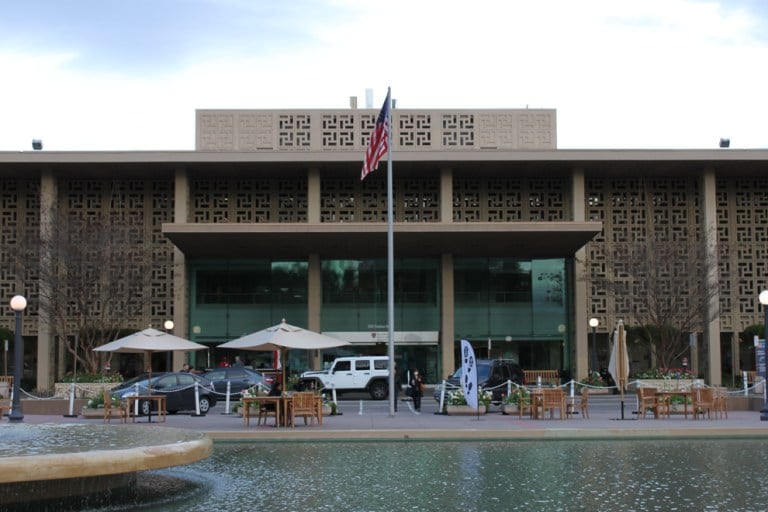“#GetMePPE.”
Healthcare workers in the United States — which now leads the world in confirmed coronavirus cases — have taken to social media to highlight the nationwide shortage of masks, face shields and other personal protective equipment (PPE).
Despite the national shortage, a rapid and multi-level response has helped Stanford Hospital maintain a steady supply to front-line workers, according to hospital administrators.
At the helm of Stanford Health Care’s response is a PPE conservation task force assembled in mid-February. An additional “leadership PPE Task Force subcommittee” was started “about two weeks ago,” Stanford Health Care spokesperson Julie Greicius told The Daily on Sunday.
The hospital has received contributions from large manufacturers and individual donors alike, according to Stanford Health Care Vice President of Supply Chain Amanda Chawla.
To date, Chawla said, PPE has come from opening new supply channels with manufacturers, soliciting donations from the community, preserving supplies by canceling elective cases in the hospital and encouraging discretionary use of PPE by healthcare workers.
According to Stanford Health Care President David Entwistle, the task force has committed “tremendous” resources to securing protective equipment, and shipments are arriving every day.
“Because the supply chain is made up of what’s coming in versus our demand/utilization — which changes daily — it is very fluid,” Chawla said. “At this time, we have sufficient supplies, and are closely managing to ensure we have what we need if we see an increase in patients in the coming weeks.”
Safety on the frontlines in an unprecedented time
PPE is essential for doctors, nurses and other hospital staff to conduct patient care.
“These are the masks that we use to protect the providers, the nurses, and the staff when we’re doing procedures in taking care of patients,” said Alexei Wagner, an emergency medicine physician at Stanford Hospital, in an interview with NBC.
Students held a PPE drive from Thursday to Sunday at the Stanford Shopping Center, bringing in more than 4,000 N95 masks and 10,000 surgical masks for local hospitals and clinics. The group plans on holding another series of drives this week.
But, Wagner said that shortages at Stanford may be imminent: “We are definitely running low on some of the most important personal protective equipment, particularly N95 respirator masks.”
Healthcare workers in contact with asymptomatic patients are encouraged to distinguish between high and low risk procedures for transmission of coronavirus, said Stanford Health Care Vice President of Perioperative Services Sam Wald. Exercising discretion over PPE usage for either class of procedure “saves PPE for [healthcare workers] for the future, for when [they] really need it,” Wald added.
This picture of measured PPE conservation is far from the disheartening accounts bearing out elsewhere in the country, as disrupted international supply chains, a delayed response from the federal government and soaring prices have contributed to a catastrophic shortage.
Snapshots of conditions on the ground include a hospitalist who made her own mask from a coffee filter. Another claims to have shared one mask between himself and his wife, both of whom are emergency doctors. Still others are depicted wearing Halloween masks and ski goggles in lieu of protective gear.
Earlier this month, news outlets reported that dozens of U.S. healthcare workers were sick, and that hundreds were quarantined for coronavirus. But, the number of healthcare workers affected today is less clear.
Only California, of the 10 states leading the U.S. in infections and deaths from COVID-19, publicly reports its figures; as of Wednesday, 35 healthcare workers had been confirmed to have coronavirus. Nationally, the Centers for Disease Control and Prevention, medical associations and healthcare worker unions have also not yet released data on healthcare workers.
Stanford’s testing, if representative, provides a benchmark. Stanford Health Care Chief Medical Officer Norman Rizk said tests done outside Stanford yield positive coronavirus rates for 11-12% of healthcare workers. Meanwhile, rates of infection at Stanford are sixfold lower: About 2% of healthcare workers test positive, said Rizk, who “believe[s] most of that’s acquired by community spread.”
PPE shortages and pernicious competitive practices
Amid the shortage, individuals, healthcare institutions and states have begun competitively bidding for a limited supply of PPE. Costs for PPE soar, and sellers price gouge buyers for remaining supplies.
For instance, Amazon buyers searching for “masks” at Stanford would find that mask varieties are often either sold out or delayed in delivery times.
One vendor, earlier this week, was selling 20 N95 masks and promising two-day delivery — but for a 600-fold markup, at $299.99. Earlier versions of the page, accessed using a cache, reveal that the vendor had surreptitiously changed its listing to avoid Amazon’s crackdown on price gouging, enabling the vendor to mark up prices exorbitantly.
Such predatory practices by sellers not only capitalize on buyers’ fears, but also limit access for workers on the frontlines.
This line of reasoning may be intuitive. But, a day later, the $299.99 masks had all been purchased.
Contact Yasmin Rafiei at yrafiei ‘at’ stanford.edu.
